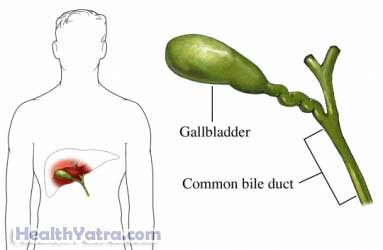Definition
Jaundice is a yellow discoloration of the skin, mucus membranes, and whites of the eyes.
Causes
Jaundice occurs when excess bilirubin builds up in the blood. Bilirubin is a yellow-brown colored substance in bile. Bile is a liquid that carries waste products and bilirubin away from the liver. It also helps break down fats in the small intestine. It is formed during the body’s normal process of breaking down red blood cells.
There are several reasons why too much bilirubin can build up in the blood. They include:
- Excess breakdown of red blood cells, which can occur in:
- Certain forms of anemia
- Some infectious diseases like malaria
- A blockage in or near the liver that prevents the flow of bile, such as:
- Gallstones or pancreatitis
- A tumor in the liver or bile duct
- Pancreatic cancer
- Congenital defects
- Pregnancy

- Liver damage caused by:
- Viral hepatitis
- Cirrhosis
- Alcoholic liver disease
- Adverse effects of certain medicines or environmental toxins
- In babies, insufficient amounts of a certain liver enzyme during the first two weeks of life
- Inherited metabolic disorders, including Gilbert, Crigler-Nager, and Dubin-Johnson syndromes
Risk Factors
Factors that may increase your chances of getting jaundice are similar to risk factors for liver and gallbladder disorders. They may include:
- Drinking too much alcohol
- Using illicit drugs
- Taking medicines that may harm the liver
- Being exposed to hepatitis A, hepatitis B, or hepatitis C
- Being exposed to certain industrial chemicals
Symptoms
Jaundice may indicate another condition or disease. In addition to jaundice, you may experience other symptoms. Symptoms may include:
- Fatigue
- Itching
- Fever or chills
- Unexplained weight loss
Diagnosis
Your doctor will ask you questions about your symptoms and medical history. A physical exam will be done. In order to make a diagnosis on what is causing jaundice, your doctor may recommend tests. Tests may include:
- Blood tests
- Ultrasound
- CT scan
- Cholangiography
- ERCP test
- Laparoscopy
- Liver biopsy
Treatment
In most other types of jaundice, the specific condition causing it must be treated. There are many treatments that may be used for liver and gallbladder problems depending on the exact condition. They include:
- Avoiding a substance, like alcohol or medication, that is causing the condition
- Addressing the cause of anemia
- Taking medication to treat infectious diseases
- Relieving bile duct obstructions by:
- Excising tumors
- Extracting gallstones
- Removing the gallbladder
- Treatingpancreatitis
Mild jaundice in newborns is common and usually clears without treatment. If bilirubin levels rise above a certain level, the baby may receive phototherapy, which is treatment with a special ultraviolet light. In Gilbert syndrome, jaundice tends to clear without treatment.
If you are diagnosed with jaundice, follow your doctor’s instructions.
Prevention
Prevention depends on the disorder causing jaundice. You may not be able to prevent some of the disorders. However, you can take the steps below to decrease your chance of developing liver disease:
- Limit your alcohol intake to no more than two drinks a day for men or one drink a day for women.
- Be careful mixing alcohol with over-the-counter and prescription medication.
- Avoid exposure to industrial chemicals.
- Do not use illicit drugs.
- Do not share needles or nasal snorting equipment.
- Practice safe sex.
- To decrease your risk of hepatitis A, get the hepatitis A vaccine.
- To decrease your risk of hepatitis B, get the hepatitis B vaccine.
